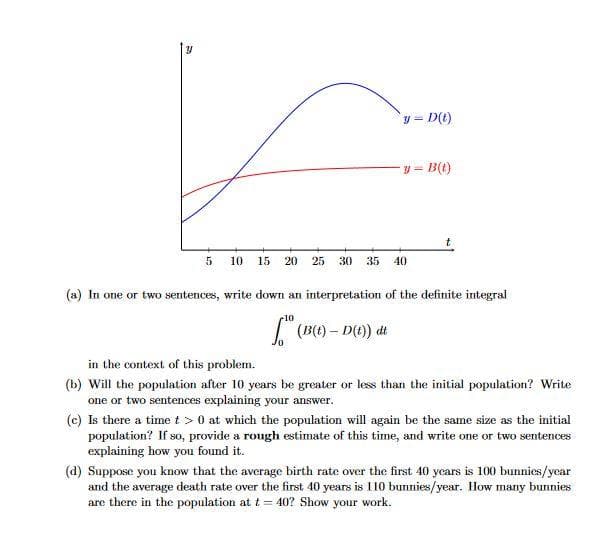y = D(t) y-B(t) 5 10 15 20 25 30 35 40 (a) In one or two sentences, write down an interpretation of the definite integral 10 (B(0) - D(0) dt. in the context of this problem. (b) Will the population after 10 years be greater or less than the initial population? Write one or two sentences explaining your answer. (c) Is there a time t> 0 at which the population will again be the same size as the initial population? If so, provide a rough estimate of this time, and write one or two sentences explaining how you found it. (d) Suppose you know that the average birth rate over the first 40 years is 100 bunnies/year and the average death rate over the first 40 years is 110 bunnies/year. How many bunnies are there in the population at t=40? Show your work.
y = D(t) y-B(t) 5 10 15 20 25 30 35 40 (a) In one or two sentences, write down an interpretation of the definite integral 10 (B(0) - D(0) dt. in the context of this problem. (b) Will the population after 10 years be greater or less than the initial population? Write one or two sentences explaining your answer. (c) Is there a time t> 0 at which the population will again be the same size as the initial population? If so, provide a rough estimate of this time, and write one or two sentences explaining how you found it. (d) Suppose you know that the average birth rate over the first 40 years is 100 bunnies/year and the average death rate over the first 40 years is 110 bunnies/year. How many bunnies are there in the population at t=40? Show your work.
Algebra & Trigonometry with Analytic Geometry
13th Edition
ISBN:9781133382119
Author:Swokowski
Publisher:Swokowski
Chapter4: Polynomial And Rational Functions
Section: Chapter Questions
Problem 5T
Related questions
Question
Please help me.

Transcribed Image Text:y = D(t)
y-B(t)
5 10 15 20 25
30 35 40
(a) In one or two sentences, write down an interpretation of the definite integral
-10
(B(1) - D(t)) di
in the context of this problem.
(b) Will the population after 10 years be greater or less than the initial population? Write
one or two sentences explaining your answer.
(c) Is there a time t> 0 at which the population will again be the same size as the initial
population? If so, provide a rough estimate of this time, and write one or two sentences
explaining how you found it.
(d) Suppose you know that the average birth rate over the first 40 years is 100 bunnies/year
and the average death rate over the first 40 years is 110 bunnies/year. How many bunnies
are there in the population at t = 40? Show your work.
Expert Solution
This question has been solved!
Explore an expertly crafted, step-by-step solution for a thorough understanding of key concepts.
Step by step
Solved in 3 steps with 1 images

Recommended textbooks for you

Algebra & Trigonometry with Analytic Geometry
Algebra
ISBN:
9781133382119
Author:
Swokowski
Publisher:
Cengage

Algebra & Trigonometry with Analytic Geometry
Algebra
ISBN:
9781133382119
Author:
Swokowski
Publisher:
Cengage